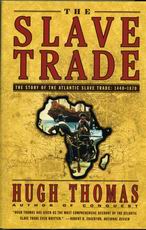
The Slave Trade
The Story of the Atlantic Slave Trade 1440 - 1870
Thomas, Hugh
Publisher: Simon & Schuster
Year Published: 1997
Pages: 909pp ISBN: 0-684-83565-7
Library of Congress Number: HT985.T47 Dewey: 382'.44
Resource Type: Book
Cx Number: CX11914
A comprehensive history of the Atlantic slave trade in which approximiately eleven million black slaves were carried from Africa to the Americas to work on plantations, in mines, or as servants in houses.
Abstract:
Hugh Thomas's The Slave Trade details the rise of the Atlantic slave trade in the 1400s through to its subsequent abolition more than five centuries later. Thomas begins by reporting that by the Middle Ages slaves had already been in use in Northern Africa and the Mediterranean for hundreds of years. In the late Middle Ages, African slaves were transported to Portugal and Spain. The slave trade in Europe had begun.
The Portuguese were the first to sail down the West coast of Africa on slaving expeditions during the 15th century, but other countries such as Spain, France, and Great Britain followed soon after.
The colonization of the New World brought the demand for slaves to its peak because, as Thomas explains, Africans seemed "strong" enough to work plantations and mines while "docile" enough so as not to revolt. Most of the great enterprises of the New World, such as the cotton, rice, sugar, and gold industries, were based on labour by slaves. Despite this, Thomas argues that the slave trade did not significantly affect every industry, and that it could not be said that the capital generated by slaves made the industrial revolution possible. Politically, the slave trade strengthened the monarchies of the European countries involved in it and helped fund noblemen of the African countries from which the slaves originated.
Memories of the great civilizations of old that had been built by slaves dominated the minds of those colonizing the New World. Thomas believes that it was neither economics nor prudence that ended slavery, but the work of philanthropists and politicians from every slaving country. The history of the Atlantic slave trade is punctuated with grand and tragic stories of the extravagant lives of slavers and the brutalities they committed, as is Thomas's work, but throughout their plight Africans managed never to lose their great dignity, patience, and spirit.
[Abstract by Oliver Mao]
Table of Contents:
List of Maps
Introduction
BOOK ONE: GREEN SEA OF DARKNESS
1. What heart could be so hard?
2. Humanity is divided into two
3. The slaves who find the gold are all black
4. The Portuguese served for setting dogs to spring the game
5. I herded them as if they had been cattle
6. The best and strongest slaves available
7. For the love of God, give us a pair of slave women
8. The white men arrived in ships with wings
BOOK TWO: THE INTERNATIONALIZATION OF THE TRADE
9. A good correspondence with the blacks
10. The black slave is the basis of the Hacienda
11. Lawful to set to sea
12. He who knows how to supply the slaves will share this wealth
BOOK THREE: APOGEE
13. No Nation has plunged so deeply into this guilt as Great Britain
14. By the grace of God
BOOK FOUR: THE CROSSING
15. A filthy Voyage
16. Great Pleasure from our wine
17. Slave harbors I
18. Slave harbors II
19. A great strait for slaves
20. The blackest sort with short curled hair
21. If you want to learn how to pray, go to the sea
22. God knows what we shall do with those that remain
BOOK FIVE: ABOLITION
23. Above all a good soul
24. The loudest yelps for liberty
25. The gauntlet had been thrown down
26. Men in Africa of as fine feeling as ourselves
27. Why should we see Great Britain getting all the slaves Trade?
BOOK SIX: THE ILLEGAL ERA
28. I see…We have not yet begun the golden age
29. The slaver is more criminal than the assassin
30. Only the poor speak Ill of the Slave Trade
31. Active Exertions
32. Slave Harbors of the nineteenth Century
33. Sharks are the invariable outriders of all slave ships
34. Can we resist he torrent? I think not
35. They all eagerly desire it, protect it and almost sanctify it
36. Cuba, the forward sentinel
Epilogue: The slave trade: a reflection
Appendix 1. Some who lived to tell the tale
Appendix 2. The trial of Pedro Jose de Zulueta in London for trading in slaves
Appendix 3. Estimated statistics
Appendix 4. Selected prices of slaves 1440-1870
Appendix 5. The voyage of the Enterprize
Sources and Notes
Index
Illustration Credits
LIST OF MAPS
The Atlantic slave trade
Medieval Trans-Saharan Caravan Routes
Portuguese discoveries in the late 15th century
The Caribbean in the 18th century
The kingdom of Congo in the 16th century
Slave harbors of North America in the 18th century
Brazil in the 18th century
Slave harbors in the 18th century
The Naval Patrol
Slave harbors of the 19th century
Subject Headings


